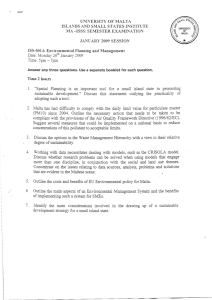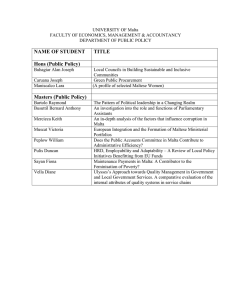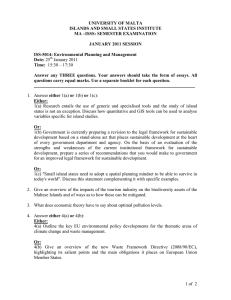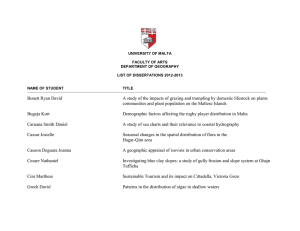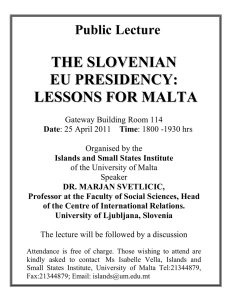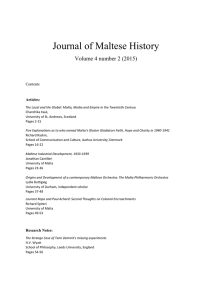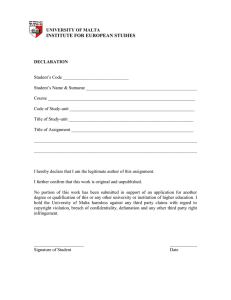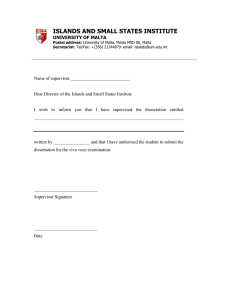Document 13550153
advertisement
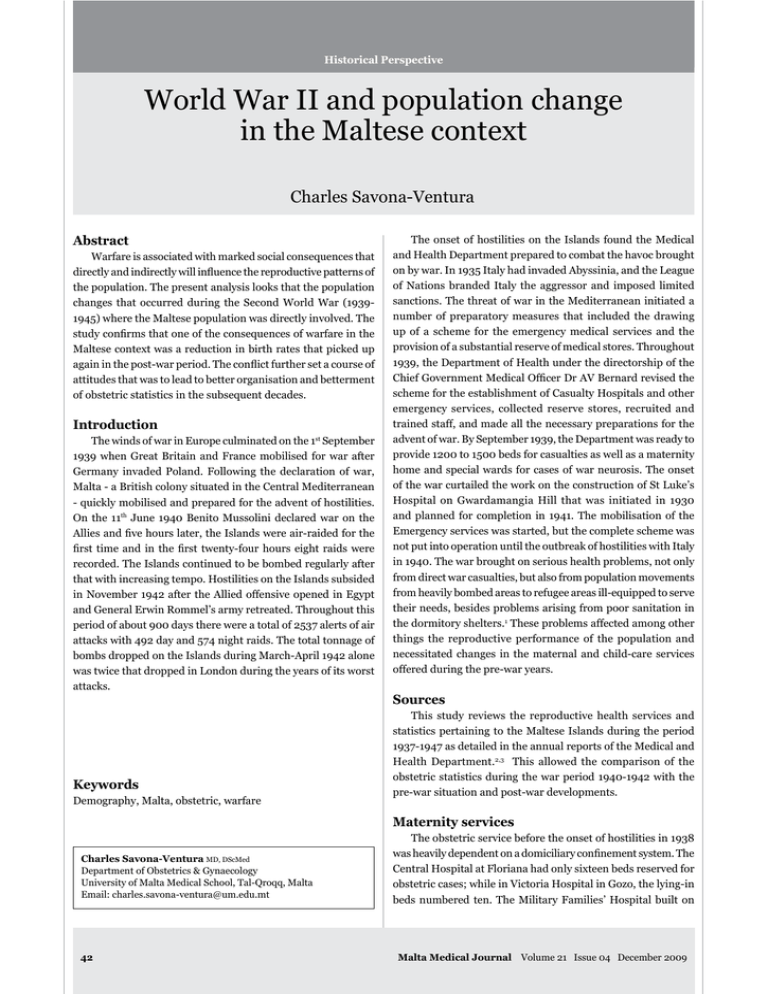
Historical Perspective World War II and population change in the Maltese context Charles Savona-Ventura Abstract Warfare is associated with marked social consequences that directly and indirectly will influence the reproductive patterns of the population. The present analysis looks that the population changes that occurred during the Second World War (19391945) where the Maltese population was directly involved. The study confirms that one of the consequences of warfare in the Maltese context was a reduction in birth rates that picked up again in the post-­war period. The conflict further set a course of attitudes that was to lead to better organisation and betterment of obstetric statistics in the subsequent decades. Introduction The winds of war in Europe culminated on the 1st September 1939 when Great Britain and France mobilised for war after Germany invaded Poland. Following the declaration of war, Malta - a British colony situated in the Central Mediterranean -­ quickly mobilised and prepared for the advent of hostilities. On the 11th June 1940 Benito Mussolini declared war on the Allies and five hours later, the Islands were air-­raided for the first time and in the first twenty-­four hours eight raids were recorded. The Islands continued to be bombed regularly after that with increasing tempo. Hostilities on the Islands subsided in November 1942 after the Allied offensive opened in Egypt and General Erwin Rommel’s army retreated. Throughout this period of about 900 days there were a total of 2537 alerts of air attacks with 492 day and 574 night raids. The total tonnage of bombs dropped on the Islands during March-April 1942 alone was twice that dropped in London during the years of its worst attacks. Keywords Demography, Malta, obstetric, warfare The onset of hostilities on the Islands found the Medical and Health Department prepared to combat the havoc brought on by war. In 1935 Italy had invaded Abyssinia, and the League of Nations branded Italy the aggressor and imposed limited sanctions. The threat of war in the Mediterranean initiated a number of preparatory measures that included the drawing up of a scheme for the emergency medical services and the provision of a substantial reserve of medical stores. Throughout 1939, the Department of Health under the directorship of the Chief Government Medical Officer Dr AV Bernard revised the scheme for the establishment of Casualty Hospitals and other emergency services, collected reserve stores, recruited and trained staff, and made all the necessary preparations for the advent of war. By September 1939, the Department was ready to provide 1200 to 1500 beds for casualties as well as a maternity home and special wards for cases of war neurosis. The onset of the war curtailed the work on the construction of St Luke’s Hospital on Gwardamangia Hill that was initiated in 1930 and planned for completion in 1941. The mobilisation of the Emergency services was started, but the complete scheme was not put into operation until the outbreak of hostilities with Italy in 1940. The war brought on serious health problems, not only from direct war casualties, but also from population movements from heavily bombed areas to refugee areas ill-­equipped to serve their needs, besides problems arising from poor sanitation in the dormitory shelters.1 These problems affected among other things the reproductive performance of the population and necessitated changes in the maternal and child-care services offered during the pre-war years. Sources This study reviews the reproductive health services and statistics pertaining to the Maltese Islands during the period 1937-1947 as detailed in the annual reports of the Medical and Health Department.2,3 This allowed the comparison of the obstetric statistics during the war period 1940-1942 with the pre-war situation and post-war developments. Maternity services Charles Savona-­Ventura MD, DScMed Department of Obstetrics & Gynaecology University of Malta Medical School, Tal-­Qroqq, Malta Email: charles.savona-ventura@um.edu.mt 42 The obstetric service before the onset of hostilities in 1938 was heavily dependent on a domiciliary confinement system. The Central Hospital at Floriana had only sixteen beds reserved for obstetric cases; while in Victoria Hospital in Gozo, the lying-in beds numbered ten. The Military Families’ Hospital built on Malta Medical Journal Volume 21 Issue 04 December 2009 Mtarfa Hill was responsible for the soldiers’ families. Prof. Joseph Ellul, then Senior Accoucheur & Gynaecologist at the Central Hospital, noted that “the number of beds available in the great wards (of the Central Hospital) is very limited and there are always many extra beds in the corridor.....Whilst abnormal cases are admitted as emergency cases; normal cases are only taken in if patients are very poor and if beds are available...... During these last 10 years patients have become hospital minded, especially when they are suffering from some complication of pregnancy. It is a pity that some of these are refused admission for lack of beds.” The number of births in 1938 at the Central Hospital reached 343, accounting for only 4.3% of the total number of infants born in Malta during that year. Victoria Hospital in Gozo played a more important role with 164 confinements accounting for 22.2% of the total births on that island. The majority of women delivered at home with midwife assistance, doctors being called in when problems with delivery occurred. Referral to the hospital was often a late event.2,4 A district-based midwifery system was organised with Malta and Gozo being divided into 12 and 4 districts respectively. To ensure that the inhabitants residing in outlying villages had the facility of obtaining trained help during childbirth, the Medical and Health Department subsidised midwives to enable them to reside in these villages. In addition free midwifery assistance was made available to needy mothers during their confinement and the puerperium. The attendance of the District Medical Officers was available free of charge to poor mothers. During 1939, the Maternity and Child Welfare services continued with little change from the previous years. The Military Families’ Hospital was reorganised as the 90th General Hospital and maternity services were transferred to King George V Hospital at Floriana.2,4 These services continued up to the month of May 1940. After the onset of hostilities in June 1940, mass movements of population occurred from heavily bombed areas. In view of war conditions, it was envisaged that a much larger proportion of mothers of all social classes would seek admission to the hospital. An Emergency Maternity Hospital was opened at Hamrun in Malta in a newly-constructed wing of the Adelaide Cini Orphanage increasing the number of maternity beds to 100. The maternity services were transferred initially on the 28th May 1940 to the Bugeja Technical Institute and eventually on the 19th June to the Cini Orphanage situated close-by. By the end of the year, after seven months, 637 maternity patients were treated as in-­patients, while 482 confinements had taken place in the hospital. In Gozo, the situation in the maternity services remained unaltered in spite of the relative increase in the number of births on that Island resulting from the exodus of several families from Malta to that less vulnerable island. Victoria Hospital with 167 confinements accounted for 21.5% of total deliveries that occurred in Gozo that year.3,4 During 1941 district maternity services were expanded by the establishment in many of the villages of maternity-cubicles dugout in bomb-proof shelters. A convenient part of a rock- Malta Medical Journal Volume 21 Issue 04 December 2009 shelter in these villages was specially conditioned and set apart for the confinement of mothers who preferred to remain near their homes rather than go to hospital. They were allowed to come in a few days before confinement was expected and to remain for about a week after the event. They were attended by their own midwife or doctor, unless they opted for free treatment by the District Midwife or Medical Officer. The scheme worked satisfactorily and no cases of sepsis were recorded. Payment of midwife fees on behalf of poor mothers was in 1941 given in 230 cases amounting to £114. At Cini Maternity Hospital, the maternity patients were transferred from the upper to the lower floor of the building at the end of April 1941. The hospital in-patients during 1941 numbered 1066; while 931 infants were born in the hospital including 12 twins. On the 9th May several incendiary bombs were dropped in the courtyards of the hospital. There was no damage other than the burning of some curtains. Explosive bombs fell in the hospital grounds on the 8th September, but only caused blast damage to windows and doors. By the end of 1941, a spacious rock-shelter was ready with room for practically all the patients at Cini Maternity Hospital, equipped with an Operating theatre, and Labour Ward with running water, electricity, and tiled walls. The first confinement in this shelter took place on the 13th November. At Victoria Hospital in Gozo, 188 confinements took place accounting for 25.6% of all Gozitan births. 3 During 1942, bombardment from the air was heavy during the first seven months, but abated towards the end of the year. During the earlier part of that year, maternity cubicles under rock were provided in several more villages. District midwifery continued at a constant pace with midwives fees being subsidised in 170 cases costing £102. Cini Maternity Hospital similarly continued to function at a steady rate with 971 maternity in-­patients and 810 confinements. Bombs fell on or near the hospital on several occasions, the worst damage being inflicted on the 12th February 1942 when the sleeping quarters of the Sisters of Charity and those of the orderlies were destroyed and the provisions stores severely damaged. One medical officer and a fatigueman were injured. Victoria Hospital in Gozo accounted for 117 confinements. King George V Hospital at Floriana was destroyed by enemy action on 7th April 1942 and the maternity services there were transferred to the Cottonera Military Hospital (now St. Edward’s School).3,4 The hostilities against the Islands ceased after November 1942. During the subsequent year there was a marked decrease in the number of patients who made use of the institutionalised maternity services, a situation that continued subsequently. During 1943, there were a total of 479 maternity in-patients with 351 confinements amounting for only 4.6% of deliveries in Malta, a significant decrease from the 13.3% contribution in 1942. Victoria Hospital in Gozo registered 66 deliveries accounting for 8.4% of total births in Gozo, approximately half the rate registered during the war (Table 1). Early in 1944, partial demobilisation of the Emergency Medical Services was carried out. However, Cini Maternity Hospital continued to function as a maternity hospital well until 1949 when the services 43 were transferred to the now-­completed St Luke’s Hospital at Gwardamangia.3,4 Infant health care was based on two complimentary systems. The government-­organised service was based on the distribution of District Nurses spread over 16 regions in Malta and Gozo. These nurses visited homes where births occurred and worked in close association with the District Medical Officers. They helped, among other things, to keep in check the neonatal mortality rate to a level of 44.2 per 1000 live-births for the period 1937-39. In addition Government gave money grants to necessitous mothers of infants under one year, the rates being fixed by the Commissioners of Charity. In 1938, the sum of £613 was distributed among 315 cases. The government also contributed the sum of £450 to the Mother’s and Infant’s Health Association which maintained four infant health centres in Malta. In addition volunteer helpers visited newly confined mothers in the harbour region and its suburbs in Malta.2 With the onset of hostilities in Malta, the Department of Health undertook steps to augment the services. The number of District Nurses was increased to 27, employment being given to those nurses who had just completed a special course started in 1939. The newly recruited staff was distributed among those districts that contained the greatest number of shelters and refugees. Besides visits to the newly-­confined mothers, the nurses made frequent inspections of shelters and refugee centres. More beds for babies were provided at the Central Hospital in Malta and the management of the Children’s War Memorial Hospital, situated in the top floor of a religious-­run hospital at St. Julians in Malta was taken over by the Department of Health. These wards were subsequently transferred for more space and better protection to a ward improvised in the ground floor of the Sacred Heart Convent situated close by. Dr. Walter Ganado, then acting Professor of Physiology at the University of Malta, was detailed for infant welfare work. Besides frequently visiting dormitory shelters and refugee centres, mothers were instructed on the care of their infants. One or two clinics per week were held in each district. At every clinic instruction was given to all mothers who attended for the first time, and infants were examined and their mothers advised regarding the condition of their child and his requirements. Dr. Ganado also delivered a series of lectures to mothers, midwives and District Nurses emphasising the necessity and advantages of breast-­feeding. Two talks on the subject were broadcast on the cable radio system.3 Obstetric statistics The birth rate of the Maltese Islands prior to 1939 varied little fluctuating around a mean of 33.26 per 1000 population. The onset of the war in middle of 1940 had very little effect on the birth rate that year, except that proportionately more births were recorded in Gozo than in Malta as a result of the mass migration of families. In 1941, the birth rate in both islands dropped markedly and continued to drop in 1942. The cessation of hostilities at the end of 1942 showed its effects the following year with a rise in the birth rate (Figure 1). The sudden and marked diminution in the birth rate is not surprising in view of the marked disturbance to family life brought on by the war. Communal living, e.g. one family and even more than one family living in a single room, and the conglomeration of families in dormitory shelters necessitated by the continuous air attacks and the destruction of dwelling houses, were the most important factors in determining the lowered natality. The calling up of a large number of men to the services may also have contributed, though the marriage rate in 1941 (8.2 per 1000 population) Figure 1: Births - Maltese Islands 1937-1948 Table 1: Hospital-based deliveries Year Malta Hospital deliveries No 1938 1939 1940 1941 1942 1943 1944 343 357 482* 931 810 351 488 Gozo % Maltese births 4.3 4.4 11.0* 14.1 13.3 4.6 4.8 Hospital deliveries No % Gozitan births 164 188 167 188 117 66 68 22.2 25.3 21.5 25.6 17.2 8.4 8.0 * data available only for June-December 1940 44 Malta Medical Journal Volume 21 Issue 04 December 2009 Figure 2: Stillbirth (per 1000 total births), Neonatal (per 1000 live births) Figure 3: Infant Deaths (per 1000 live births) actually went up to levels higher than pre-war rates (7.3 in 1939). Conscription in Malta was introduced early in 1941. Conscripts were not forced to serve outside Malta, though they could volunteer for Foreign Service if they wished. The poor nutrition of the population resulting from the blockade may also have interfered with reproductive function. Reluctance to conceive in war conditions may have also boosted birth control attitudes. The fact that with the resumption of semi-­normal life by 1943, the birth rate returned to near normal levels suggests that the most important factor was probably the disturbance to family life. The signing of armistice on the 8th May 1945 and the subsequent return of the men in the services to the Islands may have contributed to the persistently increased birth rate levels of the post-­war period. The post-­war marriage rate increased significantly from 7.5 per 1000 population in 1942 to 9.8 in 1943 and 1944.2,3 In spite of the concentrated efforts to improve the maternity and infant care services, the infant mortality increased during the first three months of the war, mainly from a greater incidence Malta Medical Journal Volume 21 Issue 04 December 2009 Figure 4: Maternal mortality rates of diarrhoeal disease, though deaths from congenital debility including prematurity were also higher than previous years. The cessation of hostilities saw a marked drop in the infant mortality rate (Figures 2 and 3). The post-­war decline in both the infant and neonatal mortality rates was attributed to a lower incidence of measles, whopping cough and diphtheria; the employment of sulphonamides in respiratory and intestinal disease; and the intensive work of the Health visitors. The main factor however was the improvements in the economic conditions of some classes of the population, the more rational use of foods and the greater care bestowed in general on the requirements of health. In addition, following the increase in the marriage rate during the war, a greater proportion of the births consisted of first born infants allowing for better infant care.2,3 The adverse situation in health conditions and nutrition during the war years appeared to have had no significant effect on the stillbirth rate, this being overall lower during the war years than previously. The rate continued to decline in the post-­ war period. The decline during the war may be attributed to by a greater pre-pregnancy attendance particularly at the hospital. This increased attendance may have been stimulated by the allowance of special rations, such as milk, given to pregnant mothers. The increased supervised number of deliveries also helped decreased the stillbirth rate (Figure 2). Similarly the war years showed very little overall effect on maternal mortality, so that in spite of the adverse conditions the mortality rate during the war years was slightly lower. The decline continued further after the war. The main factor operative in bringing down the mortality was better control of infection, which included the use of aseptic techniques and the introduction of sulphonamides (Figure 4).2,3,4 Conclusions The Second World War in Malta brought about major disruption in the social structure of the population besides being involved in direct conflict that resulted in significant numbers of war casualties. This social disruption brought on marked epidemiological changes. The disturbance caused to family life from the direct and indirect effects of the war activity resulted in a marked decrease in the reproductive fertility of the Maltese 45 population resulting in a marked decrease in the birth rate, in spite of an increase in the marriage rate. The disturbance to normal life brought on differing attitudes towards obstetric care, with more patients attending antenatal care at the hospital and approximately twice as many hospital confinements. These trends returned to pre-war levels after cessation of hostilities, but may have been influential in stimulating the continuing trend towards hospital delivery that started in the 1950’s.5 In spite of the active efforts of the Department of Health to accelerate Maternal and Child Health Services, the infant and neonatal mortality rates increased significantly during the war years mainly from diarrhoeal disease and congenital debility, disease which have social factors influencing their epidemiology. The maternal mortality rate figures showed a decrease during the war years reflecting the better-­supervised intrapartum care and the newly organised facilities available from the reorganisation of the health services. When these figures are compared to rates reported from other European countries during the war years, it appears that the Islands have similarities to both occupied and unoccupied countries. This reflects the efficiency of organisation on one hand absent in occupied countries, and the restrictions and food shortages on the other absent in unoccupied countries.6,7,8,9 The food shortage experienced by the population in general and the obstetric population in particular during the years of the conflict in Malta had long term consequences. Women born during the war years have been shown to give birth to infants with a statistical significantly higher mean birth weight then their counterparts born before and after the conflict years. This observation suggests that newborns born during the Second World War were “programmed” by the nutritional restrictions and were possibly more likely to be prone to develop adult-onset metabolic disease.10 In contrast, the First World War was characterised by no direct conflict activities in the Maltese Islands. It did however bring about social and economic consequences, culminating in the Sette Gunio riots, which were apparently associated by changes in population growth and reproductive function. The First World War conflict serves to emphasise the importance of the social aspects that influence human reproduction, including the influence on maternal and perinatal mortality.11 The hardships suffered by pregnant women during the war have been well documented by De Domenico when he wrote “In his own sphere the civilian has earned His Majesty’s reward 46 (The George Cross) just as much as any fighting man....If any one section is to be singled out let it be the Women of Malta. Under the most trying circumstances the housewife maintained an unbroken service to her menfolk .....She it was who bore sons to Malta, despite the incessant din of battle, carrying her unborn burden up and down the stiff shelter staircase perhaps as often as ten times daily. She it was who bore without complaint the revolting atmosphere of the undergrounds, when in her plight any scent and every smell should have sickened her. She it was, who when her time came, laboured whilst death rained from the skies, and when the child’s ears first heard the roar of battle, her thought was for his safety. She but glanced at the infant and begged that he be taken to shelter.”12 References 1. Bernard AV. Malta, G.C. 1940-­1945. In: MacNalty AS, editor. The civilian health and medical services. Volume II, The colonies;; The medical services of the Ministry of Pensions;; Public health in Scotland; Public health in Northern Ireland. London: HMSO; 1955. p. 16-44. 2. Department of Health. Annual reports on the health conditions of the Maltese Islands and on the work of the Medical and Health Department for the year 1938-­39. Malta: Government Printing Office;; 1939-40. 2 vol. 3. Department of Health. Reports on the health conditions of the Maltese Islands and on the work of the Medical and Health Department including the Emergency Medical Services for the years 1940-­47. Malta: Government Printing Office;; 1941-­49. 7 vol. 4. Savona-­Ventura C. The history of maternity care in the Maltese Islands. Malta: Association for the Study of Maltese Medical History; 2003. 5. Department of Health. Report on the health conditions of the Maltese Islands and on the work of the Medical and Health Department for the year 1955. Malta: Government Printing Office;; 1957. p. 6. 6. Butler NR, Alberman ED. Perinatal problems: the 2nd report of the 1958 British Perinatal Mortality Survey. Edinburgh: Livingstone; 1969. p. 4-7. 7. Kerr JMM, Johnstone RW, Phuillips MH. Historical review of British obstetrics and gynaecology 1800-1950. Edinburgh: Livingstone; 1954. p. 282-5. 8. Steward WH, Cohen WJ. Infant loss in the Netherlands. Washington: National Centre for health statistics; 1968. p. 9-10. 9. Loudon I. Maternal mortality: 1880-1950. Some regional and international comparisons. Soc Hist Med. 1988;1:183-228 . 10. Savona-Ventura C, Zammit K, Vella S. Starvation and the development of the Metabolic Syndrome. Int J Diabetes & Metabolism. 2007;15:1-3. 11. Savona-Ventura C. War and population change in the Maltese context. MMJ. 2006;18(2):35-40. 12. De Domenico FS. An island beleaguered. Malta: Giov. Muscat Press; 1946. p. 131-2. Malta Medical Journal Volume 21 Issue 04 December 2009
